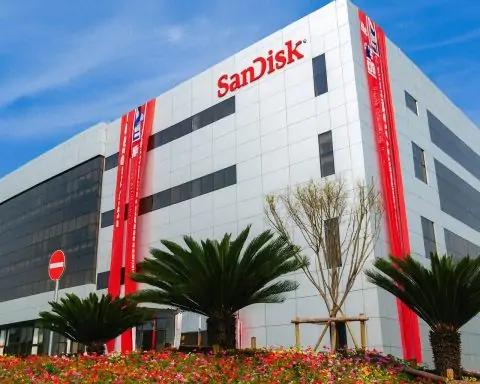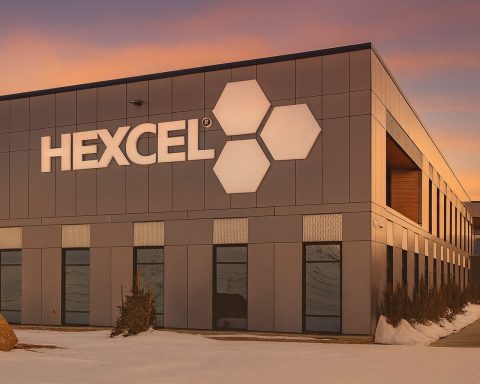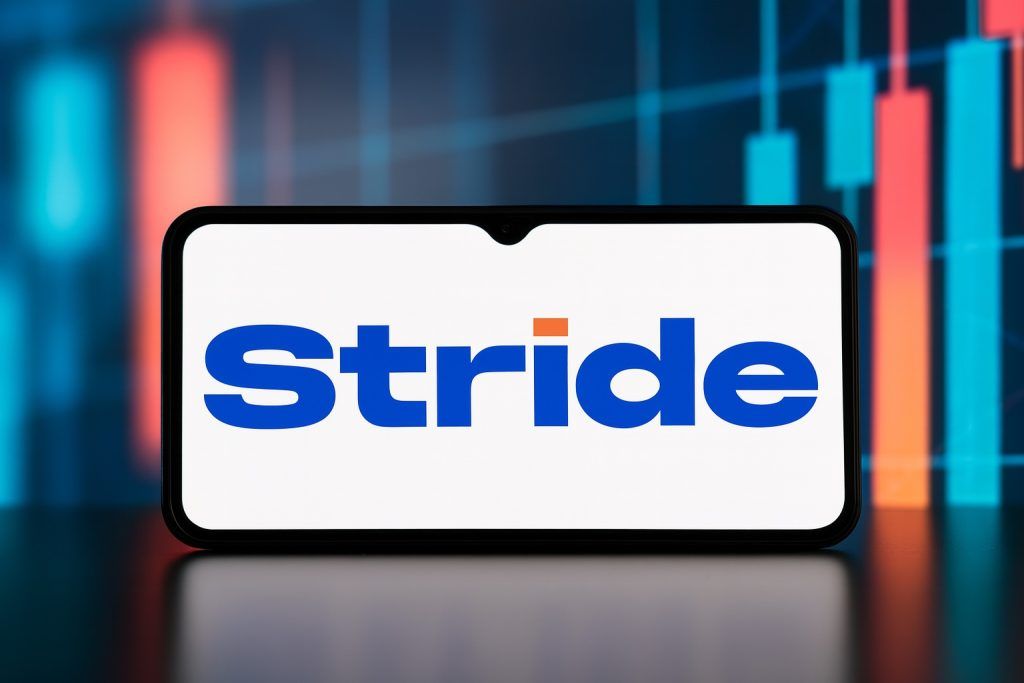- Teradyne’s shares surge: Teradyne, Inc. (NASDAQ: TER) jumped over 21% in after-hours trading on October 28, 2025, hitting new highs around the mid-$170s [1]. The stock’s spike follows a strong quarterly earnings report and an upbeat outlook, extending a multi-day rally ahead of earnings.
- Blowout Q3 results:Q3 2025 revenue came in at $769.2 million (up ~4% year-over-year), beating analyst estimates of ~$744M [2]. Adjusted EPS was $0.85, topping the $0.79 consensus [3]. Semiconductor test sales of $606 million led the quarter, driven by booming demand for AI-related chip testing [4].
- Bullish guidance: Teradyne issued Q4 guidance far above expectations, forecasting $920M–$1.0B in revenue (midpoint implies +27% YoY) [5]. This is ~17% higher than Wall Street’s ~$815M forecast [6]. Q4 adjusted EPS is guided at $1.20–$1.46 vs. ~$1.03 consensus [7]. Executives credit robust orders for AI chip test equipment for the blowout outlook.
- AI boom boosts demand: Management notes that an AI investment boom is “reverberating across the semiconductor supply chain,” fueling strong demand for Teradyne’s testing tools [8]. CEO Greg Smith highlighted that System-on-Chip testers for AI applications drove Q3 growth, alongside strength in memory test, pushing results to the high end of guidance [9].
- Leadership change: Teradyne announced a CFO transition alongside earnings. Michelle Turner, formerly CFO at L3Harris Technologies, will become CFO on Nov. 3, 2025, replacing long-time finance chief Sanjay Mehta [10]. CEO Smith said the company is “aligning our leadership structure” to capitalize on accelerating demand in AI, semiconductors, and industrial automation [11].
- Recent developments: In early October, Teradyne launched a new ETS-800 D20 test system for power semiconductors, targeting AI datacenter and EV markets. The platform enables higher parallelism and faster test times for complex devices, addressing booming needs in cloud AI and electric vehicles [12] [13]. Teradyne was also recognized by TSMC with a 2025 OIP “Partner of the Year” award for its advanced 3D chip testing solutions (Sept. 2025).
- Analyst reactions mixed: The post-earnings surge lifted TER well above many price targets, prompting split views. UBS reiterated a Buy, raising its target from $130 to $165, and sees further upside as Teradyne benefits from the AI boom [14]. By contrast, Stifel kept a Hold rating with a $135 target, implying the stock is overextended at current levels [15]. Morgan Stanley recently lifted its target to $136 (Equal-Weight), and Northland Capital to $161 (Outperform), signaling a wide range of expectations.
- Forecast & outlook: Short-term, analysts caution the 20%+ jump may invite profit-taking and volatility. Some note the stock’s valuation is now stretched by historical standards, urging investors to watch if momentum continues or cools [16]. However, medium-term sentiment is optimistic – Teradyne’s own guidance implies a sharp acceleration into 2026, and the company sees “continued momentum” as AI-related test demand remains robust across compute, networking, and memory segments [17]. Many experts view Teradyne as a key beneficiary of the multi-year AI and automation investment cycle.
Teradyne Stock Skyrockets on Earnings News
Teradyne’s stock skyrocketed after the company delivered much better-than-expected quarterly results and guidance. On Tuesday, October 28, TER shares surged ~21% in extended trading, climbing from the mid-$140s to roughly $175 – an all-time high [18]. This massive one-day move added to gains from earlier in the week, as traders bid up tech stocks ahead of Big Tech earnings. By Monday (Oct. 27), the Nasdaq had already hit fresh records on AI optimism and trade-deal hopes, with tech megacaps fueling a broad rally [19] [20]. Teradyne’s blowout report supercharged that momentum, making it one of the day’s top post-market gainers.
Recent trading: In the days leading up to earnings, Teradyne’s stock had been trending higher amid bullish sentiment on chip equipment names. The stock was hovering near ~$145 (just below its 52-week high) before the results. Notably, semiconductor shares saw volatility earlier in the month – for example, Teradyne fell ~8–9% in mid-October when U.S.–China trade tensions briefly spooked the market [21]. Despite those swings, TER entered earnings up about 10% year-to-date and poised to break out. The stellar Q3 results acted as a catalyst, sending the stock sharply upward in after-hours trading as investors piled in.
Q3 Earnings Beat Expectations
Teradyne’s Q3 2025 earnings handily beat Wall Street’s forecasts, underscoring a turnaround in demand for its semiconductor test equipment. The company reported $769.2 million in revenue for the quarter, a +4.3% increase year-over-year [22]. This topped analysts’ consensus of roughly $744 million [23]. Earnings were down from a year ago but above estimates: GAAP net income was $119.6 million (EPS $0.75) versus $145.6M (EPS $0.89) in Q3 2024 [24]. On an adjusted basis, EPS came in at $0.85, beating the $0.79 expected and only slightly below last year’s $0.90 [25] [26]. In short, profit margins held up better than anticipated even as absolute earnings were a bit lower than the prior-year quarter.
The core driver was Teradyne’s semiconductor test division. The company disclosed that Semiconductor Test revenue was $606 million in Q3, powering the overall sales beat [27]. Strong demand for testing high-performance chips – particularly those used in artificial intelligence (AI) applications – boosted orders. “Our Semiconductor Test Group delivered third quarter sales that exceeded expectations,” said CEO Greg Smith, noting that growth was “driven primarily by System-on-a-Chip solutions for AI applications and strong performance in memory” [28]. In other words, business from makers of AI accelerators, advanced processors, and memory chips (all critical for AI and cloud computing) ramped up noticeably.
Other segments were more mixed. Teradyne’s Product (System) Test unit contributed $88M and its Industrial Automation/Robotics unit $75M in Q3 revenue [29]. These areas are smaller than semiconductor test, and the robotics division in particular has seen softness (aligned with slower capital spending in some manufacturing end-markets). However, management indicated that even these segments are poised to improve as macro conditions stabilize. Overall, the Q3 report signaled that Teradyne’s downturn may have bottomed out earlier in the year, with the company now entering a new growth phase thanks to the tech spending revival.
Wall Street reacted positively to the beat. “Semiconductor testing company Teradyne beat Wall Street’s revenue expectations…and its non-GAAP profit…was 7.4% above consensus,” noted StockStory, highlighting the solid execution in Q3 [30]. The results were especially encouraging given that Teradyne (like many chip-industry suppliers) had faced a cyclical lull over the past year. The better-than-feared earnings suggest that end-customer demand – particularly for cutting-edge AI chips – is rebounding, a trend that bodes well for the coming quarters.
AI Boom Fuels a Bullish Outlook
If Q3’s beat got investors excited, Teradyne’s forward guidance truly astonished the market. The company issued a blowout forecast for the upcoming fourth quarter, well above any prior projections. Teradyne expects Q4 2025 revenue between $920 million and $1.0 billion, dramatically higher than analyst consensus (~$814M) [31]. At the $960M midpoint, sales would jump about +25% sequentially from Q3 and +27% year-over-year, according to CEO Greg Smith [32]. Such a steep rise indicates that orders are surging as chipmakers ramp production of new devices.
Crucially, this upbeat outlook is directly tied to the AI frenzy driving the tech sector. Management said the guidance “underscores how the artificial intelligence investment boom is reverberating across the semiconductor supply chain” – benefiting companies like Teradyne that make the testing and automation tools needed for chip manufacturing [33]. In practical terms, the explosion of AI model training and deployment in data centers has led to massive demand for advanced processors (GPUs, ASICs, etc.), which in turn fuels demand for Teradyne’s test equipment to ensure those complex chips meet quality standards. Teradyne’s tools are essential for validating high-performance AI chips and memory, making them a picks-and-shovels play in the AI gold rush.
Beyond revenue, Teradyne also issued much higher earnings guidance for Q4. The company expects adjusted EPS of $1.20–$1.46, crushing the ~$1.02 consensus [34]. Even the low end of guidance implies ~40% sequential EPS growth. This suggests operating leverage – as volume increases, profits grow faster than sales – and perhaps some pricing power or improved mix (AI-oriented products may carry higher margins). Teradyne likely has a backlog building for its testers, and it’s running factories at higher utilization to meet demand, which can boost margins.
Investors greeted the guidance as confirmation of the AI-driven boom extending into 2026. Teradyne’s stock jump reflected “enthusiastic” reaction to the fourth-quarter outlook, which “substantially exceeded Wall Street expectations” [35]. The midpoint of Q4 guidance ($960M) would mark record quarterly revenue for Teradyne. In a note to clients, UBS analysts wrote that they “see upside” to these forecasts given how strong orders have been, and commented that Teradyne is capitalizing on “several large, emerging opportunities” in the AI and high-performance computing space [36]. Simply put, Teradyne is riding the wave of AI capital expenditures that is benefitting not just the flashy mega-cap tech companies but also the behind-the-scenes suppliers.
It’s worth noting that management does have to execute on this ambitious outlook. One potential wrinkle flagged by UBS is a “tough memory test comp” as we transition from Q4 into early 2026 [37]. Teradyne expects a big surge in Q4, but Q1 2026 might see a seasonal or cyclical drop (especially in memory chip test, which can be lumpy). However, the company doesn’t appear worried – executives indicated they do not anticipate a shift in optimistic tone, as underlying demand drivers (AI, 5G, automotive, etc.) remain intact [38]. For now, the market is focused on the blockbuster near-term numbers and the validating signal they send about AI’s ripple effects.
New CFO and Strategic Moves
Amid the celebratory earnings news, Teradyne also announced a significant leadership change. The company will welcome Michelle Turner as its new Chief Financial Officer effective Nov. 3, 2025 [39]. Turner most recently served as CFO of L3Harris Technologies, a major defense technology firm, and brings 30 years of financial and strategic leadership experience in tech and manufacturing [40] [41]. She succeeds Sanjay Mehta, who has been Teradyne’s CFO since 2019 and will retire in 2026 [42].
Management framed this transition as positioning Teradyne for its next phase of growth. “Our industry is entering a period of accelerating demand driven by advances in AI, semiconductors, and industrial automation,” CEO Greg Smith said, adding that aligning leadership with these opportunities will help Teradyne “execute with focus and agility” [43]. He thanked the outgoing CFO for his stewardship and expressed excitement for Turner’s “broad, diverse experiences” to bolster the team [44]. The leadership shuffle thus comes at an opportune time – as Teradyne scales up for the AI boom, a fresh CFO with a background in high-tech and defense (industries used to big long-term projects) could help manage growth and capital allocation.
In addition to executive changes, Teradyne has been active on the product and M&A front to expand its capabilities:
- Product launches: Earlier in October, Teradyne launched the ETS-800 D20 tester, a dual-sector automated test system tailored for power semiconductors [45]. This next-gen system enables higher channel density and parallel test capacity – crucial for efficiently testing devices like power management chips used in EVs and AI data centers. “We are thrilled to introduce the ETS-800 D20…a cost-effective and flexible solution for high volume and high mix device testing,” said Dominic Viens, GM of Teradyne’s Power Test division [46]. The product targets the AI cloud infrastructure and automotive markets, which need robust power electronics. With EVs proliferating and server power demands rising, Teradyne is positioning this platform to capture growing demand in power device testing [47] [48].
- Industry recognition: In late September, Teradyne was awarded TSMC’s 2025 OIP Partner of the Year for its contributions to advanced chip packaging testing [49]. TSMC (the world’s largest semiconductor foundry) recognized Teradyne’s solutions for 3D chip packaging (TSMC’s 3DFabric program) – a vote of confidence in Teradyne’s ability to handle cutting-edge testing challenges. This kind of industry accolade helps Teradyne maintain strong relationships with key customers and suggests its technology remains at the forefront.
- M&A: Earlier in 2025, Teradyne agreed to acquire Quantifi Photonics, a specialist in photonic integrated circuit test, to extend Teradyne’s reach into optical chip testing [50]. That deal (expected to close by Q2 2025) reflects Teradyne’s foresight that optical interconnects will be critical in AI-era data centers (for bandwidth and power efficiency) [51]. By adding Quantifi’s expertise, Teradyne aims to offer leading solutions for testing photonic chips used in high-speed networking for AI workloads [52]. Such strategic acquisitions enhance Teradyne’s long-term growth runway beyond traditional electronics into emerging domains like silicon photonics.
All these moves indicate a company preparing for sustained growth. Teradyne is not standing still; it’s upgrading its product lineup and talent to ensure it can meet the evolving needs of chipmakers and electronics manufacturers. The market’s enthusiastic reaction to the earnings suggests investors approve of how Teradyne is positioning itself during this tech upcycle.
AI & Semiconductor Sector Context
Teradyne’s latest news comes against the backdrop of a red-hot AI and semiconductor market – one that has propelled many tech stocks to record highs in 2025, but also raised questions of frothy valuations. The so-called “Magnificent Seven” megacap tech companies have added trillions in market cap thanks to the AI frenzy [53], and broader chip industry indexes have rallied sharply on optimism that AI spending will drive a new super-cycle. In fact, the Philadelphia Semiconductor Index (SOX) is up strongly this year as investors bet on everything from AI chip designers to equipment makers.
However, this exuberance comes with volatility and risks. For example, in early October, U.S.–China trade skirmishes caused a sudden sell-off: AMD slid 7.8%, Nvidia 4.9%, and chip equipment names like Teradyne dropped ~8–9% in a single session amid fears of new export curbs [54]. That episode showed that geopolitical factors can whipsaw the sector, given its global supply chain. It also highlighted Teradyne’s exposure – as a supplier of test gear worldwide, any escalation in U.S.–China tech tensions (such as tighter controls on chip equipment exports) could impact its sales to China. Investors will need to monitor trade policy as a potential swing factor for Teradyne’s order book.
On the flip side, macroeconomic tailwinds have been supporting tech stocks recently. U.S. inflation has been cooling, and many anticipate the Federal Reserve will cut interest rates soon – with a 25 bps rate cut expected at the Fed’s Oct. 29 meeting [55] [56]. Lower rates tend to boost high-growth tech names by reducing discount rates and encouraging risk-on sentiment. Indeed, as inflation eased and rate-cut odds rose, the Nasdaq and S&P 500 notched fresh record highs going into late October [57] [58]. Teradyne has likely benefited from this broader market strength; a rising tide lifted all tech boats.
At the same time, voices of caution have grown louder about an AI bubble. Even some tech luminaries warn that valuations may be running ahead of reality [59]. For instance, OpenAI’s Sam Altman and Amazon’s Jeff Bezos both remarked that parts of the AI sector appear overvalued relative to current fundamentals [60]. JPMorgan’s CEO Jamie Dimon pointed to “bubble-like” conditions, and global regulators (IMF, Bank of England) suggested AI-fueled stock prices look stretched [61] [62]. In other words, the euphoria around AI could unwind if the promised growth doesn’t materialize quickly enough.
In Teradyne’s case, tangible results are backing up the hype, at least so far. The company’s surge in orders and optimistic forecasts serve as evidence that the AI boom is translating into real revenue and profit for suppliers down the chain. This lends some credibility to the AI rally – it’s not all speculative mania if companies like Teradyne are delivering concrete growth. “Teradyne’s results highlight the growing importance of testing equipment in the AI supply chain as chipmakers race to develop increasingly complex processors,” Investing.com observed [63]. That said, investors should remain aware that Teradyne’s fate is tied to the continued health of AI investment trends. Any slowdown in AI spending or a pause in chip capacity expansion (for example, if end-market demand for AI services pauses) could eventually soften Teradyne’s growth. For now, though, the sector outlook appears robust, and Teradyne is riding a cyclical upswing bolstered by structural drivers like AI, 5G, and electrification.
Analyst Commentary and Stock Forecast
The dramatic swing higher in Teradyne’s stock has prompted a range of analyst opinions on what comes next. Prior to earnings, the average 12-month price target for TER was around $140 [64], and the stock was trading near that level. The 20% post-earnings jump, to the mid-$170s, means the stock is now above many analysts’ targets, forcing Wall Street to update their models.
Several analysts have quickly raised their targets and ratings in light of Teradyne’s guidance:
- UBS reaffirmed a Buy rating and hiked its price target from $130 to $165 [65]. UBS’s analyst Tim Arcuri noted the exceptional Q4 guidance and “emerging opportunities” in Teradyne’s pipeline. He believes the AI-driven strength can continue and even argued there could be upside if Teradyne executes well. (Notably, UBS had already been bullish – it raised the target to $165 a week before earnings, correctly anticipating a strong outlook [66].)
- Northland Capital’s Gus Richard also upped his target significantly (from $115 to $161) while maintaining an Outperform rating [67]. He cited Teradyne’s high exposure to the AI test cycle and likely gains in market share as chipmakers invest in new test capacity. Richard sees Teradyne as a prime beneficiary of the “AI compute” trend and expects orders to remain strong into 2026.
- Bank of America reportedly raised its target to $145 (from $110 prior) [68], and Morgan Stanley to $136 (from $100) with an Equal-Weight stance [69]. These increases reflect better near-term estimates but also suggest those firms view the stock’s valuation as fairly full after the rally, given their targets are still below the current price.
On the more cautious side:
- Stifel maintained a Hold rating and, while boosting its target from $100 to $135, signaled that the stock’s run-up leaves less room for upside [70]. Stifel’s analysts pointed out that at ~$170, Teradyne is trading at a rich multiple of earnings relative to its history. They want to see how sustainable the new demand is and whether margins hold up, especially as the cycle eventually normalizes. Their $135 target implies significant downside from the post-earnings price – essentially a warning that the market may have become too ebullient.
- Goldman Sachs earlier in the year had a Sell rating (unusual on a popular tech stock) but even they raised their target from a very low $85 to around $130 recently [71]. This still reflects a skeptical view; Goldman’s thesis was that the test equipment cycle could face headwinds and that Teradyne’s robotics segment growth had stalled. After Q3, that pessimism may ease, but some segment of analysts remain wary of calling Teradyne a buy at these levels.
In summary, analyst short-term forecasts for Teradyne vary. The bulls argue that Teradyne’s strong guidance and the secular AI trend justify further gains – they see the stock potentially running higher, especially if Q4 results come in at the top of guidance or beyond. The bears (or moderates) counter that the stock has likely priced in a lot of good news, and any hiccup (such as a weaker 2026 Q1 after the big Q4, or macro setbacks) could lead to a pullback.
From an investor standpoint, much will depend on execution and external conditions. Teradyne has set a high bar for itself with the new forecasts. Any signs of supply chain constraints or customer delays could cause volatility. Conversely, if demand continues to surprise to the upside, analysts could chase the stock higher with further upgrades.
It’s also useful to consider Teradyne’s valuation: Even after the earnings pop, TER trades around 30 times forward earnings, given the new EPS run-rate. That’s above the broader market and in line with many AI-exposed peers. For a cyclical company, this multiple is elevated – it reflects confidence that we are at the start of a strong upcycle, not the peak. Investors now have to judge if Teradyne can grow into this valuation. The company’s own optimism – “AI-related test demand remains robust… suggesting continued momentum into 2026” [72] – provides support to the growth narrative. As long as the AI investment boom keeps rolling, Teradyne’s fundamentals should follow suit.
Bottom line: Teradyne’s stock has delivered impressive gains on the back of real improvements in its business. The combination of an earnings beat, a rosy outlook, and strategic alignment with key tech trends (AI, automation) presents a compelling story for shareholders. While near-term swings are possible – especially given broader market jitters and high expectations – the overall trajectory for Teradyne appears positive. The company has effectively signaled that “the AI boom is translating into revenue,” and investors have taken notice [73] [74]. If Teradyne can meet or exceed its aggressive targets, the current rally may well have further to run; if not, the stock’s volatility will remind investors that even in an AI gold rush, nothing goes up in a straight line.
Sources: Teradyne Q3 2025 earnings press release and conference call; Reuters [75] [76]; Investing.com [77] [78]; Business Wire (Teradyne CFO transition, product launch) [79] [80]; TS² (TechStock²) financial news [81] [82]; StockStory/Yahoo Finance [83]; TipRanks/The Fly analyst updates [84].
References
1. www.reuters.com, 2. www.reuters.com, 3. au.investing.com, 4. au.investing.com, 5. www.reuters.com, 6. au.investing.com, 7. www.reuters.com, 8. www.reuters.com, 9. au.investing.com, 10. www.reuters.com, 11. www.businesswire.com, 12. www.businesswire.com, 13. www.businesswire.com, 14. www.tipranks.com, 15. www.marketbeat.com, 16. www.marketbeat.com, 17. au.investing.com, 18. www.reuters.com, 19. ts2.tech, 20. ts2.tech, 21. ts2.tech, 22. www.nasdaq.com, 23. www.reuters.com, 24. www.nasdaq.com, 25. www.nasdaq.com, 26. www.financialcontent.com, 27. au.investing.com, 28. au.investing.com, 29. www.businesswire.com, 30. www.financialcontent.com, 31. www.reuters.com, 32. www.reuters.com, 33. www.reuters.com, 34. www.reuters.com, 35. au.investing.com, 36. www.tipranks.com, 37. www.tipranks.com, 38. www.tipranks.com, 39. www.reuters.com, 40. www.businesswire.com, 41. www.businesswire.com, 42. www.reuters.com, 43. www.businesswire.com, 44. www.businesswire.com, 45. www.businesswire.com, 46. www.businesswire.com, 47. www.businesswire.com, 48. www.businesswire.com, 49. finance.yahoo.com, 50. www.businesswire.com, 51. www.businesswire.com, 52. www.businesswire.com, 53. ts2.tech, 54. ts2.tech, 55. ts2.tech, 56. ts2.tech, 57. ts2.tech, 58. ts2.tech, 59. ts2.tech, 60. ts2.tech, 61. ts2.tech, 62. ts2.tech, 63. au.investing.com, 64. www.theonlineinvestor.com, 65. www.tipranks.com, 66. www.gurufocus.com, 67. finance.yahoo.com, 68. www.tipranks.com, 69. www.marketbeat.com, 70. www.marketbeat.com, 71. www.marketbeat.com, 72. au.investing.com, 73. www.reuters.com, 74. au.investing.com, 75. www.reuters.com, 76. www.reuters.com, 77. au.investing.com, 78. au.investing.com, 79. www.businesswire.com, 80. www.businesswire.com, 81. ts2.tech, 82. ts2.tech, 83. www.financialcontent.com, 84. www.tipranks.com







